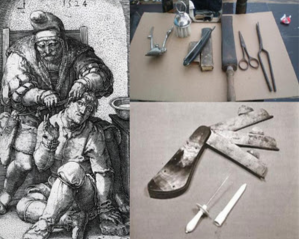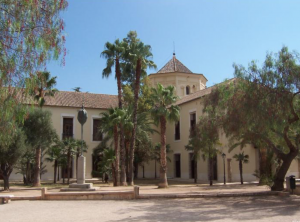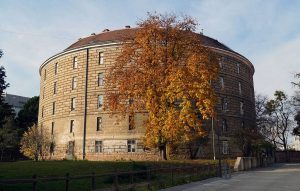—The technological revolution in medicine in the twentieth century.—
From the end of the nineteenth century, a series of factors drove a growing process of specialisation within the health professions. The traditional general practitioner, capable of solving any health problem affecting citizens – especially in his role as general practitioner – was increasingly replaced by a wide range of specialists. The unstoppable advance of medical specialisation found its main setting in the urban environment rather than the rural, and was a consequence of the rise in experimental research, in diagnosis and therapeutic medicine, in technological development and health industries, and also in wide changes in social demands. Since the Middle Ages there had in fact a pluralism of care made up of a long list of medical healthcare providers: surgeons, barbers, tooth pullers, bonesetters, veterinarians, apothecaries and midwives, but, at the beginning of the twentieth century, in the heart of medicine and in its spaces of action, specialties such as surgery, gynaecology, paediatrics, psychiatry, dermatology and syphilis specialists, dentistry and ophthalmology were established, which in the future would be the starting point for other specialties and subspecialties, according to new knowledge, social demands and technologies.

Medieval barber surgeon and his instruments. Tomás Cabacas.
Undoubtedly, the serious problem of childhood diseases and the intolerable infant mortality rates stimulated the interest and demands for doctors who dealt specifically with children’s diseases. The same was true for gynaecology and the risks surrounding pregnancy and childbirth, which resulted in high maternal mortality, as well as for psychiatry and mental diseases, sexually transmitted or dental disease. The social demands – especially of the emerging urban bourgeoisie – promoted certain specialties, as well as new technologies that opened up new expectations and unexplored fields. The discovery of anaesthetic gases such as ether and chloroform opened the door to surgical anaesthesia, while the discovery of blood groups made it possible to establish compatibilities and incompatibilities, making way for blood transfusions and haemostasis techniques. On the other hand, the microbe doctrine of infection indicated the importance of asepsis and antisepsis both in public and private spaces: in drinking water, schools, workplaces, dormitories, military barracks or operating theatres and sport places. All this created a new context for the practice of surgery, an antiseptic surgery that allowed access to the internal cavities of the animal and human organism by overcoming the three great traditional barriers to the development of surgery: pain, bleeding and infection. This was the starting point for surgical specialties and new technologies that allowed access to internal organs and tissues, the carrying out of organ and tissue transplants and the incorporation of technical advances such as laser, electric scalpels or robotics.

Medieval hospital in Bruges. Sobre Bélgica.
All these professional, technological and conceptual applications found their main setting in hospitals, spaces that throughout the twentieth century went through a profound transformation in structure, internal organisation and social function. It should be remembered that under the Ancien Régime, hospitals, linked to the concept of charity and run by certain religious orders and municipal bodies, were mainly places of social assistance, intended for the poor, the marginalised, orphans and vagrants. They were intended to mitigate the dramatic impact of poverty and social exclusion. Nineteenth century liberal reformism already applied anti-poverty laws, the so-called Poor Laws or charitable laws, turning hospitals into charitable institutions, along with homes that housed abandoned or stray children, the elderly, widows and the excluded population in general. In some cases, they were places of isolation and confinement, such as ‘lazaretos’ (leper colonies), psychiatric asylums and maternity wards. They were institutions that carried out important work of aid and social control, where health practice was not the essential thing as while unavoidable, it was still complementary.

General Hospital of Valencia, founded in 1512. Current public library of the city.
During the nineteenth century, clinical medicine was still practised in private clinics and general hospitals, with complementary institutions such as dispensaries and specific acts such as health campaigns to prevent malaria, tuberculosis, syphilis, infant mortality or trachoma. From the late nineteenth century, the development of experimental medicine based on serology and bacteriology, among other laboratory techniques, transformed the healthcare field. One of the consequences was professional specialisation. The expansion of knowledge, but also social and economic demands, influenced this. Infection and infectious and epidemic diseases were reinterpreted according to the new germ paradigm, and physiology and therapy acquired an experimental focus that required new facilities, laboratories and methods of analysis, diagnosis and therapy. This required international agreements on dosage and standards, and a flourishing industry for the diffusion of new techniques among the population. All this favoured technological development and more localist perspectives on the human body and disease.

Narrenturm (Tower of the Madmen), Vienna. Designed by the architect Canevaley. Built in 1784 by Emperor Joseph II, it was inspired by Jeremy Bentham’s panopticon. Vivir en el Mundo.
On the one hand, demographic and epidemiological statistics were used to measure the impact of disease on social groups. The data periodically provided by epidemiological indicators became the basis of medical policies on social intervention. On the other hand, the rise of the health professions, new specialties and health policies consolidated medical power and legitimised the monopoly of healing practices and their social control against unqualified practitioners. As a result, organisational spaces were created such as professional colleges (schools for doctors, dentists, pharmacists, veterinarians and nurses), associations of specialists in paediatrics, gynaecology, traumatology, venereology, and others, as well as an explosion of journals and publications for each specialty, conferences and training programs for specialists, research institutes and services and wards in hospitals. This process of professional expansion was consolidated from the mid-twentieth century within the framework of national health systems, where hospitals became the main space for the incorporation of the most innovative technology and the unstoppable process of healthcare reorganisation and medical specialisation. New areas such as allergy, rheumatology, oncology and haematology are some examples that allow us to understand the process of subspecialisation that in recent years has led to the emergence of specialties such as transplant surgery, sports medicine, or palliative care.
The universalisation of care within the health systems of the welfare state and the technological revolution driven by the health industries have transformed health care, especially since the mid-twentieth century. First came X-rays (1896), which provided the unprecedented achievement of visualising the inside of the organism without jeopardising its integrity. Then came electrocardiography (1903), applied to research on cardiac physiology and later to clinical care. The great health catastrophes of the early twentieth century and the two World Wars drove the great expansion of the pharmaceutical industry (antibiotics, painkillers, vitamins, tranquillisers, psychopharmaceuticals, chemotherapeutics, serums, vaccines, antivirals…) and finally the revolution in diagnostic techniques originating in particle physics and electronics applied to medicine. If during the 1950s clinical analyses, ultrasound and laser surgery were the main technical innovations, from 1970 the confluence of computer science, microelectronics and particle physics revolutionised the ability to visualise and intervene in the human body. This has resulted in the clinical use of the scanner, endoscopy techniques, pacemakers, computed axial tomography (CT), magnetic resonance imaging or positron emission tomography (PET). Technologies at the service of diagnosis and therapy, which have fed a powerful sanitary industry, giving medicine immense power over the human body and disease.
Josep Lluís Barona Vilar
IILP-UV
How to cite this paper:
Barona Vilar, Josep Lluís. Hospitals and medical specialities. Sabers en acció, 2021-02-12. https://sabersenaccio.iec.cat/en/hospitals-and-medical-specialities/.
Find out more
You can find further information with the bibliography and available resources.
Recommended reading
Barona Vilar, J.L. Salud, tecnología y saber médico. Madrid: Ed. Fundación Ramón Areces; 2004.
Cooter, R.; Pickstone, J. (eds.) Companion to Medicine in the Twentieth Century. London and New York: Routledge; 2003.
Cunningham, A.; Grell, O.P. Health Care and Poor Relief in Protestant Europe 1500-1700. London: Routledge, 2002.
Luce, J.M.; Byyny, r.l. The evolution of medical specialism. Perspectives Biol Med, 22, (1979), 377-389.
Risse, G.B. Mending bodies, saving souls: a history of hospitals. Oxford: Oxford University Press, 1990.
Rosen, George. The Specialization of Medicine with Particular Reference to Ophthalmology. New York: Froben Press; 1944.
Studies
Barona, J.L. El especialismo médico contemporáneo. In: El médico de familia en la historia. Madrid: Doyma; 1999, p. 79-88.
Bowers, B. S. Medieval Hospital and Medical Practice. London: Ashgate; 2007.
Dingwall, R.; Rafferty, A.M.; Webster, Ch. An Introduction to the Social History of Nursing. London: Routledge.
Harrison, Mark, et al. eds. From Western Medicine to Global Medicine: The Hospital Beyond the West. New Delhi: Orient Longman; 2008.
Henderson, John, et al. (eds.) The Impact of Hospitals 300–2000. Oxford: Peter Lang; 2007.
Hinojosa, J. (ed.) Hospital General de Valencia 1512-2012. 3 vols. Valencia: Provincial Council; 2012.
Pestre, D. Science, argent et politique. Un essay d’interprétation. Paris, Editions Quae, 2003.
Puerto Sarmiento, J. El mito de panacea. Compendio de Historia de la terapéutica y de la farmacia. Madrid: Dopce Calles; 1997.
Scheutz, Martin et al. (eds.) Europäisches Spitalwesen. Hospital and Institutional Care in Medieval and Early Modern Europe: Institutionelle Fürsorge in Mittelalter und Früher Neuzeit. Wien/München: Oldenbourg Verlag; 2009.



